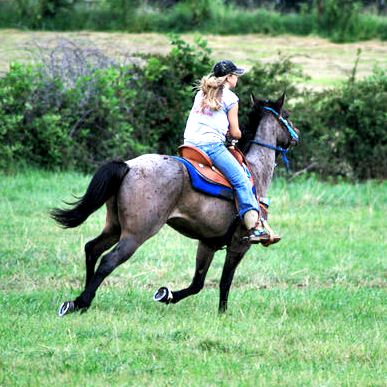 A common scenario in horse ownership goes something like this: “We were shopping for a horse for our teenage daughter and found the perfect gelding. A seasoned show horse with a willing attitude…his owner assured us he would fulfill all of our expectations. Two months after bringing him home, he became headstrong, barn sour, started balking, and eventually rearing. Our daughter no longer enjoyed riding, and stopped going to the barn altogether. Now we’re stuck paying board for a horse nobody wants to ride. What went wrong?”
A common scenario in horse ownership goes something like this: “We were shopping for a horse for our teenage daughter and found the perfect gelding. A seasoned show horse with a willing attitude…his owner assured us he would fulfill all of our expectations. Two months after bringing him home, he became headstrong, barn sour, started balking, and eventually rearing. Our daughter no longer enjoyed riding, and stopped going to the barn altogether. Now we’re stuck paying board for a horse nobody wants to ride. What went wrong?”
While every case is different, this story is all too familiar. Horses that seem perfect with one rider become sour and balky with a different rider. Many times, it is a combination of things that contribute and work together to produce a hard-to-manage horse. What can be done, other than to cut your losses, re-sell the horse (often at a loss, since you can’t demonstrate that the horse is safe to ride), and try to find a more suitable one?
One of the initial things to look at is the type of feed and excercise the horse is used to at the time of purchase, and what changes have been made since that time. A horse that is over-fed with high-energy grain and not ridden sufficiently to use that energy can develop some bad behaviors rather quickly. If your horse maintains weight well and is healthy, it is likely he doesn’t need a lot of grain, as long as he is fed good-quality hay and minerals. Many new owners feel an urge to pamper their horse and make sure he has the best of everything. But just like feeding children too much candy, feeding too much grain can cause trouble with your horse.
Educate yourself about the caloric content of the feed you are using. Grains contain 30 to 50% more energy than hay, and corn and wheat contain more calories per pound weight than other grains, such as oats. So if your horse was previously fed 5 lbs. of oats a day, and when you purchased him you started feeding him 5 lbs. of corn or sweet feed a day, you are actually feeding him maybe twice the amount of calories he is used to, hence his need for more activity, and furthermore, unwanted behavior. You should take into consideration the amount and types of grain you are feeding, and perhaps feed more hay instead, cutting back on grain to just a pound or so. Then monitor his weight and appearance, continue working and riding him, and see if his behavior improves.
You should also consider the excercise your horse needs. If he is kept in a stall most of the time, he may need daily turnout in a pasture where he can move about freely and use up some of his pent-up energy. Longeing your horse for fifteen or twenty minutes before riding is also a great habit. It not only prepares your horse’s body by warming him up and taking off the edge of his energy, but it also prepares his mind to pay attention to you and obey your commands before you ever step foot in the stirrup. And make sure you’re riding him often, as you can’t expect a horse to maintain good riding habits if he seldom gets a chance to use them.
While riding, keep him attentive by riding actively, not passively. For example, have a set plan for your riding and expect him to obey it. Even if you’re in an arena, pick out certain areas that you want him to turn at, or stop at and back up, or complete figure eights, circles, serpentines, trot over poles, around barrels, and so forth. Even on a trail ride, don’t let him meander around and make all of the decisions. You decide where he walks, which side of the tree he passes by, and how fast or slow he travels. If you are a take-charge rider, your horse will form a habit of letting you lead. Many new riders expect their horse to make all of the decisions and then are surprised when things go wrong for them.
Another thing to watch is your own riding habits and how you are handling the horse. Many beginning riders have received their horse education solely from the movies. For instance, they believe they will be able to gallop their horse into a sunset, leap over a running stream, and ride down the side of a mountain like The Man From Snowy River. Attempting these things on the average horse will most likely end up in disaster. Most horses are more difficult to control at a faster speed, and a beginning rider should be supervised and instructed by a professional until they are ready and able to handle the horse safely on their own. Horses can quickly develop bad habits when ridden improperly, and then that is all they will want to do. Like the photo above of the girl racing away on her blue roan, if running is all you ever do on a horse, pretty soon that horse will no longer stop when you ask it to. Don’t make these typical beginner mistakes, because it will ruin a good horse.
It has been said, “There are no problem horses, only problem riders.” If your new horse has developed some imperfections, it might help to have a talk with the previous owner and ask them to give you a few suggestions for you and your new horse. Chances are they’ll be able to give you some riding tips as well as let you know what the horse is used to. It’s also a great idea to sign up with a riding instructor for a few months and take lessons on your new horse. Having a knowledgeable professional there to observe could completely alleviate any problems you and your horse are having, because they will be able to give you advice based on your horse’s needs. If the horse is exhibiting dangerous behavior, you might send him away for training on those problem areas before you attempt to ride him again. While the expense for lessons or training might be more than you were planning for, there is no substitute for staying safe and protecting yourself, and it will be money well-spent if it helps you through the transition of getting to know your horse and gaining a better understanding of how to handle him.
If your dream horse has become a nightmare to deal with, don’t give up. Get a trainer to help you, cut back on the grain a little, and keep riding. With some adjustments, you’ll hopefully regain the perfect horse you started out with.

